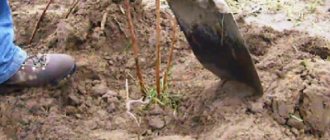When is the best time to plant lawn grass: spring or autumn?
Choosing a good time for sowing lawn grass largely depends on the region, seed material, soil conditions, and their location. In addition, it is worth considering that crops in spring and summer require more careful care in the first days. Soil preparation, weed control, fertilization - there are differences depending on the season. But summer and spring shoots will please you immediately, but autumn shoots will have to wait until next year. If you sow a lawn in the spring, then for the first 2-3 weeks it is necessary to moisten the soil and actively get rid of weeds. In summer, do not allow it to dry out on hot days. It is good to apply fertilizers with nitrogen in the first spring months for active growth and development.
In the fall, less watering will be required, the weeds are no longer so active, and the sprouts will have time to get stronger before frost. Some gardeners even plant in frozen ground, before snow cover appears. In this case, the seeds undergo stratification, becoming stronger and acquiring disease resistance. In the fall, it is better to fertilize with potassium and phosphorus; to strengthen the root system, much less nitrogen is required at this time so that the seedlings can easily tolerate low temperatures.
Note! In spring, it is better to sow lawn grass in early May; in autumn, September (no later than the 25th) or November (if there is no snow) is suitable. For summer planting, it is recommended to choose a rainy, windless period so that the seedlings do not dry out.
When to sow a lawn in the fall
There are two options for sowing in autumn. The first is to plant the grass in September or before October 15th. If you're lucky, it will have time to germinate, but not to its full potential. The second option is to plant a lawn before winter, when the air temperature drops to -3 °C. The number of seeds is doubled (approximately 1.5 kg per 30 m2). The first shoots of grass will delight the eye in April, and in the summer it will grow in full force.
Sowing a lawn with a hydroseeder
Advantages of autumn sowing
Each season has its pros and cons for planting lawn grass. Each gardener chooses his own time, analyzing for himself all the possibilities and advantages. Autumn sowing is preferable for a number of reasons:
- the absence of heat, which allows you to pay less attention to watering, has a beneficial effect on seed germination;
- soil and air humidity without sharp fluctuations;
- weeds are no longer growing as actively as in the spring;
- sprouts sprout in a dense layer and grow higher;
- the root system is formed stronger, and the grass is resistant to diseases;
- the soil does not require long preparations.
Is it possible to sow lawn grass before winter?
To grow a beautiful and high-quality lawn, you need to devote a lot of time to preparing the soil. In the spring, this is very difficult and takes a lot of time, so the best option for planting lawn grass is late autumn.
During this period there is a lot of rain, so watering should not be carried out; suitable air temperature also has a beneficial effect on grass seeds.
Pre-winter sowing is recommended when the outside temperature is not less than zero, but not more than five degrees Celsius (the last days of October and the beginning of November are considered optimal). It is important to cover the sown seeds with mulching soil, which must include peat.
The first shoots will emerge above the ground in early spring. After overwintering, the seeds become strong and hardened, so in the future they can easily withstand various temperature changes and weather disasters, and the lawn becomes disease-resistant.
Gardeners recommend planting a lawn before the winter months; it is believed that such grass looks more attractive than lawns planted in the summer or spring.
Features of autumn lawn planting
In the spring, before planting, it is necessary to clear the lawn of debris, apply fertilizer, and then let the soil lie fallow for at least 40 days. Sometimes this requires a lot of time, which is more important to spend on planting vegetables, herbs, pruning bushes and trees. Seeds planted in the fall will not require complex care when spring arrives, but with the onset of warm weather they will quickly begin to delight with their greenery. During autumn and winter, the sprouts form a strong root system, which only emerging weeds cannot greatly affect.
You may be interested in: There is no piece of land that is not attacked by weeds.
As for the lawn, the weeds look ugly on it and... What kind of lawn grass destroys weeds Read more...
If the winters in the region are harsh, you will have to cover the lawn with peat and spruce branches to insulate it. It is difficult to correct autumn seedlings if they have sprung unevenly, because there is no time to correct them. In this case, you will have to finish sowing or redo it completely in the spring. The choice of seeds must be more careful so that the varieties can survive the winter without dying. In areas with a slope, it is better not to plant lawn grass in the fall, because when the snow melts, spring meltwater washes the seeds out of the soil.
Note! Autumn sowing should not be delayed too much; all work must be completed no later than 30-40 days before the start of frost.
Important Tips
- When sowing, pay attention to the location of the lawn on the site. In lowlands, stagnant water forms, and this will have a bad effect on the quality of the lawn.
- Try to calculate the sowing time so that after planting at least 30 - 40 days pass before the first sub-zero temperatures. During this time, the plants will get stronger and more easily survive the winter.
- If your region is characterized by autumn with periodic thaws, then the lawn can be planted at the first frost, even at the first snow. This way the seeds harden and the lawn grows, and early greenery will appear in the spring.
Grass varieties for planting
Now you know when and how to plant lawn grass, it’s time to choose seeds to put your knowledge into practice. In our country, the climate is quite harsh, so even experienced agronomists cannot ensure the growth of all plant varieties. 3 types of grass are ideal for domestic realities: meadow bluegrass, red fescue and thin bentgrass. All of them are not afraid of heat or frost, and the root system of the plants forms a very dense turf, leaving no chance for weeds. Grass consumption is about 30 thousand seeds per 1 square meter.
As mentioned above, each variety has its own characteristics. Red fescue germinates slowly and provides a beautiful lawn only in the second year. Meadow bluegrass does not grow a root system well, so you should not plant it yourself. The thin bentgrass, as such, has no disadvantages: it tolerates winter well and is not too demanding to care for. Often this plant is the main component of the mixture.
Preparing the area for a lawn
To get a beautiful lawn on your site, you need to prepare the site in August.
Lawn seeds should be planted before the end of September. Before planting lawn grass, you need to let it rest for three weeks. Site preparation involves:
- clearing the area of debris;
- all plant remains that are present on it should also be removed;
- if on the piece of land that you have set aside for a lawn there are diseased trees or bushes, then they should also be uprooted.
After this, the ground must be dug up to the depth of a full spade bayonet. To make it easier to control pests when caring for your lawn, you can chemically treat the area in advance using herbicides. If the area is neglected or has not been cared for for a long time, then it is necessary to treat the area where the lawn will be planted at least twice.
Drainage for lawns on moist soil
If the soil on your site is excessively moist, then in this case it is necessary to carry out work on installing a drainage system .
- To do this, you need to remove the top fertile layer with a shovel and put it aside;
- After this, the cleared area is compacted and then covered with pebbles. You can use broken bricks instead. You should end up with a layer 15-20 m thick;
- On top of this layer, you then need to lay coarse sand in a layer of 10 cm;
- After this, everything should be carefully leveled. A special roller is usually used for this. If you don’t have such a machine at your disposal, then you can use an ordinary log. When leveling, it is necessary to make a slope towards the paths or drainage hole;
- After the leveling is completed, it is necessary to replace the fertile layer of soil that was removed at the beginning of the work.
A prerequisite for obtaining a beautiful and high-quality lawn is fertilizing the area allocated for the lawn. It is necessary to use mineral fertilizers, which will allow you to get good grass shoots next year that will grow evenly.
Tools needed for planting and care
How to plant lawn grass on the site
To prepare the soil, and then plant and care for the lawn, the following tools are required:
- metal and wooden rakes;
- wooden slats 1 m long (several pieces for leveling the area);
- mosquito net (used to protect seeds from exposure to sunlight);
- fertilizer (special lawn or complex): 50 g per square meter;
- watering can with fine spray;
- scales.
Of course, you will need high-quality seed material (preferably grafted) or several strips of rolled lawn.
Oats, rye and other cereals are often used for sowing. Best grasses for lawns in the south:
- meadow bluegrass;
- meadow fescue;
- ryegrass
Residents of the northern regions are recommended to give preference to grass mixtures intended for Siberia and the Urals.
If desired, lawn crops can be combined independently in suitable proportions, checking the success of the chosen combination on the site next to the dacha.
Thus, there is no specific time frame for planting a lawn. You can sow seeds at any time of the year, except winter. When choosing a time for planting, you need to consider the advantages and disadvantages of each season of the year.
How to prepare the ground for planting a lawn
The land for planting must be very well cultivated and fertilized.
Choose a flat area, without depressions or holes. Otherwise, after rains, water will stagnate in the lowlands, and the lawn will quickly lose its beauty in such places.
- If there are holes, fill them in and level the surface.
- The area is cleared of debris, weed roots, and other grass.
- The top layer of soil is removed using the bayonet of a shovel and drainage made of sand or fine gravel is laid.
- Geotextiles can be laid over the drainage, but this is not necessary. Geotextiles will not allow any weed to reach the surface of the lawn and, if desired, the lawn can be easily rolled up and moved to a new location.
- Then a layer of fertile soil is poured and the surface is leveled using a fan rake.
- It will be possible to plant a lawn in about 2 weeks, when the soil settles and becomes compacted.
For a healthy lawn, the “correct” acidity of the soil is important. Ph should be approximately 5.5. Before sowing, find out the acidity of the soil in the area; if it is low, you can sprinkle with lime, mix with soil and water thoroughly.
Earth compaction
One of the final stages is compacting the soil, which is necessary to level its surface in order to avoid problems in the future while operating the lawn mower (breaking blades when hitting uneven areas, tearing out plants along with their roots in uncompacted areas). In addition, this procedure also has an aesthetic function.
Did you know? The world's smartest lawn, covering an area of 4 thousand m², decorates the area near the Canberra Parliament building in Australia and waters itself using a computer.
Tamping is carried out in different ways, with special or improvised means:
- roller;
- vibrating plate;
- a log or a large heavy board, with ropes attached to the sides for the work of several people;
- a barrel filled with water and capable of rolling;
- small boards attached to the feet with shoes and allowing gradual movement;
- a concrete ring rolling over the future lawn with the help of people.
You need to compact it until traces of human feet stop appearing. The procedure should be completed with abundant watering to completely stabilize the soil.
Installation of drainage systems
If the site is located in a lowland, groundwater lies close to the surface, and water stagnates during rainfall and irrigation - a drainage system should be created. These works are carried out in parallel with the process of leveling the soil. Drainage serves to eliminate excess water and maintain air-water balance in the soil.
The drainage system can be arranged in various ways:
- The top fertile layer of soil 15–20 cm thick is removed. Crushed stone, expanded clay or pebbles with a layer of 12 cm are laid and compacted along the entire perimeter in an even layer. Sand is poured on top of the first drainage layer (layer 10–15 cm), and it is also leveled and compacted. A previously removed layer of fertile soil is placed on top of the drainage, which also needs to be leveled and compacted.
- Drainage holes are constructed under the lawn. The number of such pits corresponds to the size of the plot. They dig them with a shovel. The shape of the hole is cubic, dimensions 60 × 60 × 60 cm. At the bottom of each recess, broken bricks or small pebbles are placed in a layer 40 cm high. Sandstone is poured on top of the stone with a layer of 10 cm, and then fertile soil (layer of 10 cm).
- Specialists are invited to install a drainage system in the form of pipes.
Step-by-step instructions for autumn sowing of a lawn
After building a house and improving the surrounding area, you can devote time to the lawn. In order for the process to be successful, and for the green cover to please the eye in the spring, it is necessary to take into account the rules that will make this process easier and more effective. The choice of seeds, soil preparation, and fertilizers are important steps, the observance of which will allow you to decorate the site for a long time.
Autumn planting dates
In the fall, it is possible to sow the seeds twice - at the end of August, beginning of September, or in October, early November. In the first case, it is important to take into account that at least 40-45 days must pass between the planting period and the onset of frost. In this case, a strong root system will have time to form, and the above-ground part will grow up to 10 cm. Sudden night frosts can destroy crops, so it is better not to delay this process, starting a little earlier.
Before winter, sowing at the end of October, beginning of November is possible even in frozen soil. In this case, the seeds will undergo a natural process of stratification, which makes it possible to grow active and friendly seedlings in the spring. To prevent the seed material from dying, it is worth considering the planting time when choosing grass varieties. There are also risks - if after sowing warm weather suddenly returns with temperatures above +5°C, then the germination period will begin, as a result of which the seedlings will die from the cold.
Site preparation
Before sowing, the land must be properly prepared so that the result is a beautiful green carpet in front of the house. The first step is to completely clear the area of anything that might interfere:
- construction garbage;
- stones that cannot be included as an addition or island;
- branches;
- old stumps;
- dry bushes, trees.
In an area where nothing has been planted for a long time, or where it is being cultivated for the first time, it is better to treat the soil with herbicides. Then, during germination, minimal weeding will be required.
When the place has been cleared and processed, it is necessary to start digging to remove small plant roots and remaining debris. It is better to lighten clayey, viscous soil by adding fine gravel or sand, then aeration will be better. Add compost or humus to the sandy soil. For good growth of lawn grasses, the optimal acidity is 5.5-7 pH; if it is higher, liming is carried out with lime or dolomite flour.
In areas with high humidity, it is better to arrange drainage:
- Remove the top layer of soil.
- Stones, broken bricks, pebbles are poured on top in a layer of 15-20 cm.
- Lay a layer of sand 8-10 cm thick.
- The surface is leveled and compacted with a special roller or thick log.
- Return the removed fertile layer to its place.
On a note!
If a drainage system or automatic drip irrigation is provided, their installation is carried out at this stage, while the top layer is removed.
Allow 10-15 days for the soil to settle, after which the territory is leveled again, filling in the holes and leveling the hummocks. Now you can apply fertilizers with potassium and phosphorus, or special mixtures for lawns. The granules are properly mixed with the soil using a rake, leveling along the entire perimeter. Finally, compact again with a roller or thick log, and water generously for additional stabilization.
Methods for compacting earth on the site
After the soil has been leveled, it must be compacted so that when germination occurs, the layer is more even, and during mowing, the lawn mower does not “stumble” over uneven surfaces, breaking the blades. On an uncompacted lawn, the seeded grass will be uprooted during the first mowing. Level the area with a vibrating plate or a special roller until there are no traces left when walking. Not everyone is ready to spend money on purchasing additional equipment that may be used once, so sometimes they use other devices:
- a wide board or log with ropes tied at the ends;
- barrel filled 1/4 with water;
- boards tied to feet or slippers;
- concrete ring.
You may be interested in:
Leucanthemum nevus: growing from seeds We share the secrets of how to grow beautiful and healthy Leucanthemum nevus flowers from seeds. Delicate flower with…Read more…
Treating the area with herbicides
There are many different preparations on the shelves for gardeners, so when choosing, questions arise - which ones to choose and how to use them correctly so as not to harm the plantings. To maintain a beautiful lawn, it is necessary to regularly weed or treat with herbicides, and in order for fewer weeds to grow initially, the treatment process must begin even before sowing. Treat the soil with a herbicide and leave it for 1.5-2 weeks, after which it is leveled and planting begins.
Before using the product, you must carefully read the instructions and follow the recommended concentration. You should not add a little more - “in reserve” or for a better effect; this can lead to the concentration in the soil being too high, and it will be impossible to plant anything on it for several years.
Follow safety rules to avoid chemical burns, allergies, and irritation. To do this, you need to work with gloves and, possibly, a respirator (depending on the drug and its composition).
To avoid buying a useless or low-quality product, try to follow the recommendations of friends or colleagues.
On a note!
There are no drugs that would destroy all weeds once and for all. Regular tilling and weeding are required to keep your lawn in good condition.
Fertilizing and preparing the soil for the lawn
It is better to add fertilizers before sowing, then the minerals in the prepared soil will ensure rapid growth and development of shoots. A complex of microelements from ammonium nitrate, superphosphate and potassium sulfate is added in bulk, evenly distributed over the entire surface, excluding heaps of accumulations in one place. Magnesium and boron are diluted in water and watered. Organic fertilizers include chicken manure in dry form, mixed with wood ash (potassium) and peat.
How to scatter seeds correctly
Can I plant in the rain? It is better to sow in dry weather without wind, then the grass will take root well. The day before, the top layer is watered abundantly. Mix the seed material with sand in a 1:1 ratio and scatter it around the entire perimeter, first along, then across. After adding the seeds, the soil is loosened superficially with a rake, and then lightly compacted with a roller, and a thin layer of black soil or peat is applied for mulching. At the end, be sure to water with a fine sprinkler.
It is better to sow manually only in small areas and with experience, otherwise the sowing density will be uneven. You can use a manual or mechanical seeder. For large areas and slopes, another method is suitable - hydroseeding. To do this, create a composition of several components - hydrogel (to maintain moisture levels), fertilizers, colored mulch (visually shows where there is an insufficient layer of seeds). This mixture is applied using a hydroseeder. Seedlings planted in this way are not afraid of melt water and strong winds.
On a note!
To ensure that the roots are well strengthened, you should not walk on the lawn for the first couple of months after planting the grass!
What seeds to choose for sowing a lawn
We buy frost-resistant seeds.
Nowadays there is a large selection of lawn seeds in stores. In order not to make a mistake when choosing seeds, you need to know the purpose of the lawn. Do you have it just for beauty and won’t people walk on it? Or is it a lawn for a sports ground or a football field? It is from the destination that you need to start. Let's consider various options
- Lawn for a sports or children's playground
Ready-made seed mixtures for such sites are sold. As a rule, the word “sport” is on the packaging. The composition includes various types of plants that are resistant to trampling and can hold their shape for a long time. You can cheat a little and see what herbs are in the composition, buy them separately and make the mixture yourself.
- Decorative lawn that will not be walked on
Here you can buy a ready-made grass mixture or make it yourself. Most grass mixtures from the store will be suitable for such a lawn. Look at the composition, and you will see that it includes the same grasses - meadow bluegrass, ryegrass, red fescue or shoot-forming bentgrass, just in different proportions.
The lawn will be beautiful even if you use one type of grass. Here is the field for your experiments.
Preparing to sow the lawn
Before you start sowing, you need to find out and decide on some features. For example, when is the best time to start preparing to seed your lawn? Late spring and early autumn are perfect for such purposes; it is worst to do this in the summer months, since the grass may simply dry out and the seeds may not sprout at all.
If you want to have a perfectly smooth, beautiful, green lawn, you need to thoroughly till the soil before sowing it. First, you should determine how your site is located. If it is in a low-lying area, the ground can accumulate water after rainfall, which will negatively affect your lawn. To prevent this from happening, you need to lay drainage, it can be a gravel or sandy surface, and then start laying the soil. This is preferable to do if you plan to sow a sports type of lawn. It is also necessary to clear the area for future sowing, remove any debris accordingly, and level the soil. The soil must be dug up and cleared of weeds, roots and other plants and pests.
Clearing soil for a lawn
After you have dug up the soil, it needs to be allowed to settle and recover for about two weeks. After this period, the area can be additionally covered with a layer of plant soil, which will nourish the grass in the early stages of its growth. Additionally, it is worth checking the pH of your soil, the normal value is approximately 5.5, if your value is below this limit, the soil needs to be treated with lawn lime, and then watered thoroughly. It is definitely worth fertilizing the soil; it is best if you do this a week before sowing the grass; this will contribute to better development of the lawn, nourish it in the initial stages and accelerate the growth of the root system.
Soil preparation
Sowing a lawn with your own hands step by step
The day should be warm and windless - the seeds will not scatter, the lawn will be more lush and uniform.
- Pour the seeds into a deep container and mix thoroughly with your hands. The packages indicate the required seed consumption per 1 m². If you mixed the grass mixture yourself, then per 1 m² you will need approximately 50 - 70 g, it all depends on the composition.
- You can sow seeds manually or with a special lawn sowing device. If it is a small lawn on private property, then, as a rule, everything is sown by hand. We make sweeping movements with our arms and walk meter by meter.
- It is best to walk first along and then across the site, so the seeds will be distributed more evenly and less will be wasted.
- Then sprinkle the seeds with a layer of a mixture of peat, humus and nutrient soil, up to about 10 cm thick.
- The planted seeds must be compacted using special devices - a roller or special “skis”. At home, simple “skis” are made from boards up to 80 cm long. Belt or ski mounts are placed on the boards and put on the feet. Walking across the lawn in such “skis”, a person, with his own weight, compacts the soil with seeds. Or you can make a skating rink yourself using whatever you have at hand.
After planting the seeds, water every day if there is no rain and the weather is dry and sunny. We don’t overfill it, but we moisten it well. The first shoots should appear in 1 - 3 weeks.
Another “new” sowing method is hydroseeding
. Hydroseeding is used on slopes and large areas for lawn. Water, adhesive substances and fertilizers are added to the seeds, all this is mixed and a homogeneous liquid mass is formed, which is sprayed over the surface under high pressure. The pressure is approximately 6 atmospheres, thanks to which the seeds are firmly nailed into the prepared soil and adhere well to the surface.
Planting seeds
Planting lawn grass seeds is not an easy task. This matter has many nuances that you should be aware of. To understand how to sow lawn grass correctly, you need to understand the following point - the lawn should be planted in the absence of strong wind. This process begins with watering the soil, for which a sprinkler is used. Then you can start planting seeds, focusing on the following dosage - 40-70 g. per 1 sq. m .
If you chose autumn as the time for sowing your lawn, then the number of seeds per 1 sq. m. should be increased. In the spring, when the first shoots appear, you can sow in those areas where the seeds have not sprouted. Recent Entries
Chainsaw or electric saw - what to choose for the garden? 4 mistakes when growing tomatoes in pots that almost all housewives make Secrets of growing seedlings from the Japanese, who are very sensitive to the soil
In some cases, when planting, the mixture intended for planting is mixed with soil or sand, maintaining a 1:1 ratio. However, this practice can be abandoned. To facilitate the task of planting a lawn, use a seeder or a short wave of the hand, evenly moving along the area allocated for the lawn.
More seeds are sown on the path, as well as on the edges of the plot. As an additional measure, you can add peat, which is an excellent fertilizer. When this work is completed, it is necessary to roll over the sowed area. You need to act carefully, otherwise the wind will blow the seeds away. After this, you can water the area of your future lawn using sprinkling.
Key stages of care
To ensure that your lawn near your home always looks fresh and beautiful, you need to provide it with proper care:
- Watering. The seedlings will have to be watered 2-3 times a month. To do this, you can use the sprinkling method. Please note that for this type of watering it is necessary to select appropriate nozzles, since fragile seedlings can be washed out of the soil.
- A haircut. This procedure activates the forcing of new stems and stimulates root growth. The last haircut should be done 2-3 weeks before the onset of frost. If you do not pay attention to these manipulations, the “felt” will interfere with germination in the spring.
- Cleaning. When the mowing is finished, you need to go over the lawn with a fan rake. Mown grass cakes and interferes with aeration, which leads to rotting of the roots.
- Application of fertilizing. Potassium-phosphorus fertilizers must be applied before October.
- Aeration. Ventilation can be carried out using fan rakes and pitchforks. Piercing turf and compacted grass to a depth of 8 cm will prevent rotting, stagnation of water, and improve air exchange.
Important! The final cutting should be done when the grass has grown 6-8 cm.
Other care measures
In addition to the above, do the following:
- scarification and garbage collection . The scarifier uses knives to cut the “felt” of clipped grass and debris that has caked on the lawn, then all this is removed from the area with a rake;
- feeding with fertilizers . It is better to administer in liquid form when watering;
- weeding. Weeds only have to be removed at first. Subsequently, the established lawn grasses form a dense turf with a dense interweaving of roots and thereby crowd out the weeds. Weeding is done manually; heavily grown weeds of one type are destroyed with selective herbicides;
- overseeding _ Even the most long-lived grasses have a limited period of maintaining the grass stand. In addition, bald spots sometimes form on the lawn due to mechanical stress, dampness and other negative factors. In such areas, if necessary, add grass.
Ice crust causes great damage to the lawn. It blocks gas exchange, so it is important to break the “shell” in a timely manner. They do this with a garden roller.
Workshop: planting correctly
The scheme for planting lawn grass in the fall is as follows:
- In July-August, pay attention to soil preparation. All recesses must be filled with sand and humus and compacted thoroughly. Eliminate hummocks: remove raised soil, lay out light sod, and compact.
- 2 weeks before planting, apply lawn fertilizer, NPK complex enriched with potassium and phosphorus.
- After fertilizing the soil, level it with a rake or cultivator to a depth of 14-15 cm. This will facilitate easy incorporation of fertilizer and leveling of the lawn. After all these activities, the soil will need rest (at least a month).
Related article:
Do-it-yourself neat lawn edges: tips for gardeners
Sowing the lawn
If you are sowing by hand, spread the grass mixture in calm weather. Sow grass around the perimeter and then crosswise. To make the lawn perfectly smooth, at the end the seeds need to be scattered in a fan shape over the entire area.
Use a rake to plant the seeds. Peat is suitable as mulch. Such a cover will prevent the seeds from being washed away in the spring and will create an insulating layer.
To prevent the seeds from being blown away by the wind and becoming bird food, you will have to firmly compact them in the ground. To do this, you will have to walk around the area with a special roller.
The final stage is watering. In this case, it is necessary to use a rain irrigation system.
Advice. Fertilizers applied to the soil in the fall should not contain large amounts of nitrogen. Fertilizing organic matter is not approved, with the exception of peat, which is used during planting.
Don't walk on the autumn lawn
If you have not planted lawn grass before, you need to consider a few recommendations:
- Don't mow your grass before frost. For winter, its height should be 6-8 cm.
- Do not overseed the grass, as this can cause uneven lawn growth.
- Never leave grass clippings or litter behind. This will make germination difficult in the spring and will promote the proliferation of pests and harmful microorganisms.
- Don't water your lawn before frost arrives.
- Do not walk on the lawn in rainy weather or frosty days until it is covered with a thick layer of snow. Do not stress young grass. For work, provide a flooring made of boards.
Sanding the lawn
Autumn seedlings are not always pleasing with their density and height, so there is no need to worry about this. You can enjoy the beauty of the green carpet after cutting it next year. You will soon see that your efforts in the fall were not in vain.
Lawn care instructions
On the day of planting and before the first shoots emerge, it is necessary to water the lawn generously. You can cut your hair starting from a shoot height of 15 cm. Until the shoots get stronger, it is better not to walk on them; further care depends on the season.
| № | in spring | In summer | in autumn |
| 1 | Cleaning up last year's leaves | Combing the grass | Collecting fallen leaves |
| 2 | Adding fertilizers with nitrogen and potassium | Adding fertilizers with nitrogen and potassium | Adding Phosphorus Fertilizers |
| 3 | Watering every day | Watering 2 times a week | Watering once a week |
| 4 | Haircut from 5 to 10 cm | Regular haircut | Haircut for winter up to 10 cm |
| 5 | Weed removal | Weed removal | Weed removal |
| 6 | Aeration | Aeration | |
| 7 | Oversowing new seeds to ensure uniform cover |
Aeration is very important for development and growth - it helps provide the soil with oxygen and the roots with moisture and fertilizers. This can be done using sandals with spikes that pierce the lawn. It's enough just to walk on the grass in them. Steel rake aerators or a roller aerator (similar design, but with the addition of a spiked roller) are also suitable.
When it's damp and warm outside, mold or powdery mildew may appear. As soon as the first signs appear, spraying with a fungicide (Bordeaux mixture or other preparations) is required. Dry hot weather contributes to the appearance of yellowness; to avoid it, you should water more often, but only in the evenings.
Note! In order for the lawn to please you with its appearance, it is better to follow the rules and technologies, otherwise you will have to redo it or see an unhappy picture instead of a thick grass cover.
Laying rolled lawn in autumn
Rolled turf is most often laid in shaded and embossed areas. Planting material is prepared in special nurseries. After cutting, the upper part of the turf layer is carefully rolled into rolls and sent for sale.
Lawn soil is processed according to a standard algorithm. There is no point in delaying the placement of layers. The more time passes after removing the turf from the place where it grew, the worse the grass will take root. The laid lawn needs to be watered regularly.
When purchasing a rolled lawn, you need to carefully inspect the stripes. The good quality of the material is evidenced by the absence of crumbling grass and bald spots, and an intact root system. The thickness of the layer cannot be less than 10 cm. The grass mixture is selected based on the characteristics of the soil and climatic conditions.
Rolled lawn: what are its advantages?
The roots of the rolled lawn came from the USA. Some state laws simply prohibit having an unkempt lawn. But it’s simply impossible to plant a lawn while laying a house so that it grows simultaneously with the building (construction takes 1-2 months): construction waste, cars and building materials clearly do not contribute to the development of an ideal lawn. Therefore, large breeding companies began to create a rolled lawn: it is grown in special conditions from selected bluegrass, planted on a prepared area and can be used in just a couple of weeks. This leads to the main advantage of a rolled lawn - the possibility of very quickly landscaping any area, even in the hot summer.
In addition, a rolled lawn guarantees a high-quality composition of the grass mixture and an excellent selection of seeds, which is beyond the power of novice agronomists. The grass in the roll is grown evenly due to special equipment used during sowing. The finished layer of turf protects the lawn from the growth of weeds from the first days, while ordinary seeded grass needs to be weeded regularly.
Rolled lawn "Gorgazon": Western standards and affordable cost
“Gorgazon” has been producing rolled turf for several years now. The finished slabs are of ideal quality both in terms of the selection of seeds (only foreign selection bluegrass without any impurities), which provides the lawn with durability and a chic appearance, and in terms of lawn preparation. The seeds are planted evenly, the root system of the grass is very powerful and it is able to take root even in conditions of lack of moisture. At the same time, the Gorgazon company can offer its customers extremely competitive prices for rolled lawns. In addition, the company delivers products throughout the European part of the Russian Federation, which provides them with satisfied customers from different parts of the country. Due to this, at the initial stage it was possible to select the ideal seeds and growing conditions in order to supply only high-quality goods.
Sowing seeds in August
Installation of rolled lawn
Planting a lawn in August is convenient for those whose area is not ready for planting a lawn in the spring. It will take a long time to prepare the site, but if it is ready by early summer, you should postpone sowing until autumn, when conditions are more suitable for grass growth.
Sowing seeds
The time for sowing should be chosen so that at least 40 days remain before the onset of frost. This period will be enough for the seeds to sprout, and the plants will reach the required height, and the roots will have time to get stronger. In the middle zone and Moscow region, the lawn is planted in September. It is advisable to complete sowing work before September 10, the deadline is September 25. If planting is carried out later, the plants will not have time to grow stronger and will die.
So you can plant seeds in August, the plants will have enough time to get stronger for winter.
How to properly seed your lawn in the fall
What are the benefits of sowing lawn grass in the autumn months? The air is already quite humid, as is the soil, the air temperature is moderate, and weeds grow worse. All these factors contribute to the rapid formation of shoots and the formation of the grass root system. By sowing grass mixture seeds at the end of August or September, you will have a lawn up to 10 cm high before the first frost.
By sowing grass mixture seeds in late August or September
In addition, planting lawn grass in the fall is convenient for those whose lawn area is not yet ready for spring. It will take a lot of time until you clear the area of excess debris, compact and level the soil according to all the rules. But it is advisable to leave the soil to rest for at least another month before sowing anything on it. If you manage to prepare the site by early summer, it is better to postpone sowing the seeds until the fall, when conditions for grass growth will be more favorable.
Video about lawn grass, when to plant a lawn at the dacha, how to do it correctly
Typically, grass mixtures for lawns include several different types of grass, but they all have approximately the same requirements for air temperature and humidity. Therefore, you should choose the time for sowing seeds based on the general rule: there should be at least 40 days left before frost. Approximately this period of time will be required for the seeds to sprout, the plants to reach sufficient height, and the root system to become stronger.
In central Russia, it is advisable to complete the sowing of lawn grass in the fall before September 10, or maximum until September 25. At later dates, the plants do not have time to grow and freeze slightly.
The time for sowing seeds should be chosen based on the general rule: there should be at least 40 days left before frost
How to sow a lawn in the fall:
- in the summer, prepare the soil on the site by carefully leveling it and compacting it;
- a week before sowing, scatter a complex fertilizer with a predominance of nitrogen on the ground;
- level the soil with a rake;
- on a windless day, sow the seeds first along the site, then across it, scattering them by hand in a fan so that the seeds fall evenly on the ground;
- lightly rake the sown seeds into the soil;
- sprinkle a thin layer of peat on top and go over it with a lawn roller, otherwise the seeds will be blown away by the wind;
- water the lawn using the sprinkling method.
The video will help you better understand how autumn lawn planting occurs - open the tab to the article and see how quickly and easily everything is done in reality.
Since it rains quite often in the fall, there is no need for regular watering.
Sowing a lawn before winter
Most summer residents begin to sow after the soil has slightly frozen. This method of sowing is called winter sowing. It is distinguished from autumn in that sowing occurs in November. Seeds are planted before snow cover forms.
Note! To prevent the seedlings from dying, there must be a positive air temperature outside. After sowing, the seeds need to be mulched.
The main advantage of this sowing is that in the spring the lawn grass grows very actively. If you choose this option, you can get a beautiful lawn next year. But this option is not suitable for areas with a slope; as mentioned earlier, the seeds may simply be washed away.
When is it better to sow a lawn: in spring or autumn - it is not so important. Each method has its own advantages and disadvantages. If you sow the lawn correctly and pay due attention to it, then the green decorative carpet will decorate your garden plot for a long time.
How to care for your lawn
From the first day of sowing until the first shoots appear, the grass should be watered abundantly. The first mowing procedure takes place when the plants reach a height of up to 15 cm. Until the stems have become stronger, it is not recommended to walk on the lawn. In the future, care should be carried out according to the situation, depending on the time of year.
Did you know? In total, there are about 1 million plant species in the world, and only 350 thousand have their own names.
Only 10 thousand of them are herbaceous. A beautiful green lawn pleases the eye not only of the owners, but also of all guests of the house. But only correct and consistent preparation of the place for autumn sowing, compliance with all the rules and sequence of the process will allow you to fully enjoy this attractive picture.











